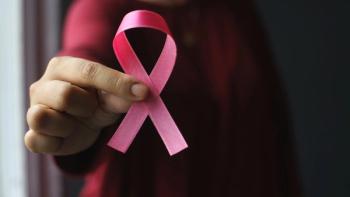
Tecvayli Outcomes Similar in Clinic And Trials for R/R Myeloma
Research demonstrated comparable outcomes in the real-world setting and in the phase 2 MajesTEC-1 trial when it came to treatment with Tecvayli for relapsed or refractory myeloma.
Safety and efficacy of Tecvayli (teclistamab-cqyv) for patients with relapsed/refractory multiple myeloma tended to be similar in the real-world setting — meaning given in oncology clinics and not on a clinical trial — as it was in the phase 2 MajesTEC-1 trial that led to the drug’s approval in 2022.
These findings, which were part of a retrospective analysis, were presented at the 2023
“(Tecvayli) appeared well-tolerated and effective in this real-world heavily pre-treated (relapsed or refractory multiple myeloma) patient population, where the majority did not meet the eligibility criteria for the MajesTEC-1 trial and had high risk disease features,” Danai Dima, a third-year fellow in the Department of Hematology-Oncology, Cleveland Clinic, Taussig Cancer Center, said during a presentation of the data. “…While (Tecvayli) was associated with early responses, durability and deepening of these responses need to be determined with longer follow-up in our real-world population.”
Real-World Efficacy Results
In the 104 patients evaluated in the retrospective analysis, the overall response rate (ORR; percentage of patients whose cancer shrunk or disappeared from treatment) was 66%, compared with 63% in the MajesTEC-1 trial, including a complete response (CR; when the cancer completely disappears) or better in 29% and 39.4%, respectively. Further, very good partial response (VGPR) occurred in 17% of patients in the analysis, compared with 19.4% in the trial, partial responses were observed in 20% and 4.2%, minimal response in 0% and 1.2%, and stable disease in 9.5% and 16.4%.
A higher number of patients in the real-world analysis (24.5%) experienced progressive disease, compared with those in the phase 2 trial (14.5%).
Dima highlighted subgroups of interest, with more than half experiencing an overall response to Tecvayli in the retrospective analysis: those 70 or older (71%), non-Hispanic Black patients (71%), those with penta-refractory (68%) and triple-refractory disease (64%), patients with a high risk for cytogenetics (63%), those ineligible for the MajesTEC-1 trial (60%) and individuals having received prior BCMA therapy (59%).
Next, the investigators evaluated response rates to Tecvayli in 56 patients who received prior BCMA-directed therapy, compared with the type they had previously received — including CAR-T cell therapy (42 patients), antibody-drug conjugates (24 patients) and other investigational agents (four patients). In total, 43 patients received at least one prior BCMA-directed therapy, 12 who received two and just one patient was given three.
Patients in the real-world study who experienced an overall response reported a longer amount of time from their last BCMA-directed therapy to the initiation of treatment with Tecvayli, compared with the MajesTEC-1 trial (339 days versus 205 days). When evaluating those who started treatment with Tecvayli within three months of their last BCMA-directed therapy, those in the retrospective study induced a lower ORR, compared with those on the phase 2 trial (42.9% versus 64.3%, respectively) and a lower VGPR or better (35.7% versus 47.6%). Lastly, among those treated with Tecvayli after six months following previous BCMA-directed therapy, lower ORRs (47.4% versus 64.9%, respectively) and VGPRs or better (35.7% vs 47.6%) were also lower within the real-world cohort. Dima noted none of these reached statistical significance.
Further, after a median follow-up of 3.8 months, 46 patients in the real-world study had progressed on the agent. Median progression-free survival (PFS; time from treatment until disease worsening or death) was 5.4 months. At data cutoff, 29 patients died, with the majority occurring after disease progression (21 patients; 86%). Median overall survival was not reached, meaning that not enough patients died for the researchers to calculate an average time until death, while the six- and 10-month rates were 70% and 67%, respectively.
Lastly, according to a multivariate analysis of the real-world data, the investigators identified ECOG performance status of 2 or more (indicating that they could not perform all daily tasks independently), extramedullary disease and four or more prior lines of therapy were associated with inferior ORR with Tecvayli, while ECOG performance status of 2 or more, extramedullary disease and age of 70 years or older were associated with inferior PFS.
Real-World Safety Results
In the retrospective analysis, any grade cytokine release syndrome (CRS; a condition where inflammatory markers called cytokines rush into the blood) occurred in 64% of patients, which was comparable to the 72% in the MajesTEC-1 trial, Dima said. Median time to onset of CRS was 3.5 days and lasted for a median duration of one day.
Any grade immune effector cell-associated neurotoxicity syndrome (ICANS) was seen in 14% of patients, compared with 14.5% in the MajesTEC-1 trial, with the median time to onset being five days and median duration of two days.
“The incidence of severe CRS and ICANS was low, so were the rates of recurrence suggesting possibly feasible outpatient (Tecvayli) step-up dosing administration, as well as administration of (Tecvayli) in the community practice after the initial step-up dosing,” Dima added.
On day 30, hematologic toxicities, which occurred in 99 patients, included leukopenia (any grade, 63%; grade 3 to 4, 19%), neutropenia (47%; 21%), anemia (71%; 16%), and thrombocytopenia (61%; 19%).
On day 90, hematologic toxicities, which occurred in 60 patients, included leukopenia (any grade, 42%; grade 3 to 4, 7%), neutropenia (42%; 15%), anemia (50%; 10%) and thrombocytopenia (47%; 8%).
In total, 31 patients experienced an infection, including severe infections (46%), infections of the respiratory system (69%), bacterial infections (41%), viral infections (51%) and fungal infections (3%) after a median onset of 46 days.
Patients were subsequently hospitalized for infection (16 patients), cytopenia (three patients), symptom control (six patients), neurotoxicity (two patinets) and acute kidney injury (one patient).
Dose delays (12 patients) and treatment discontinuation (five patients) most commonly occurred as a result of infection.
“Cytopenias and infections remain a challenge; therefore, close monitoring, supportive care and prophylactic measures with growth factors, antimicrobials, IVIG and vaccinations are important,” Dima said.
MajesTEC-1 Trial
In the phase 2 trial, 165 patients who had relapsed or refractory myeloma after at least three therapy lines were treated with Tecvayli at a subcutaneous injection dose of 1.5 mg/kg by body weight after receiving step-up doses of 0.06 mg/kg and 0.3 mg/kg. ORR served as the primary end point.
After a median follow-up of 14.1 months, the ORR was 63%, including a 39.4% experiencing a CR or better. Further, median duration of response with Tecvayli was 18.4 months, while the median PFS observed was 11.3 months. Further, common side effects were comprised of cytokine release syndrome in 72.1% of the patients, neutropenia in 70.9%, anemia in 52.1% and thrombocytopenia in 40%; while infections occurred in 76.4% of patients and neurotoxic events in 14.5%.
Based on these results, the
Further Evaluation of Tecvayli
Although the results of the phase 2 MajesTEC-1trial led to approval of the agent, the investigators noted that it had stringent eligibility criteria and may not have been representative of those patients treated in the real-world setting. For example, Dima explained, patients at the Cleveland Clinic often present with significant organ dysfunction, significant comorbidities, severe cytopenias, high-risk disease characteristics and have had prior BCMA-directed therapy exposure.
Therefore, the investigators aimed to evaluate the real-world outcomes of patients with relapsed or refractory myeloma who were treated with commercially-available Tecvayli or those in an expanded access program with the drug from August 2022 to August 2023 across five academic centers in the United States. The primary outcomes were safety and efficacy; in particular, they homed in on those who would have been ineligible for the phase 2 trial that led to the drug’s approval in the United States, as well as patients who presented with high-risk disease features.
The data cutoff for the real-world analysis was Aug. 15, 2023.
In the analysis, patients had received step-up doses of Tecvayli in two different schedules based on institutional preference.
Patients in the retrospective analysis were a median 66.5 years, including 32% older than 70, compared with 64 years in the MajesTEC-1 trial. Further, compared with the phase 2 trial, a higher number of patients in the multicenter analysis had R-ISS stage 3 disease (31% versus 12%, respectively), high-risk cytogenetics (59% versus 26%), extramedullary disease (42% versus 17%), triple-refractory disease (92% versus 78%) and were refractory to five or more prior treatments (64% versus 30%). In addition, 33% of patients in the real-world analysis had an ECOG performance status of 2 or more, while more patients in the phase 2 trial (82% versus 58%, respectively) underwent a prior autologous stem cell transplant (ASCT).
“We can clearly see that our patient population had a high proportion of patients with high-risk features,” Dima highlighted. “Certainly, our study included patients who would not qualify for the MajesTEC-1 trial. Half of these patients met one (exclusion) criteria, and the other half met two or more exclusion criteria for the (trial).”
The investigators highlighted the reasons for MajesTEC-1 trial ineligibility, and the number of patients who met that criteria in the real-world analysis, including prior anti-BCMA therapy (53%), poor performance status (33%), any baseline cytopenia (31%), renal dysfunction (13%), liver dysfunction (5%), cardiac dysfunction (4%), plasma cell leukemia (2%), amyloidosis (1%), central nervous system involvement (4%) and ASCT received less than 12 weeks before (1%).
“Efforts to balance risks and benefits with limited treatment duration, longer intervals between doses and possibly cessation of therapy for these patients who have achieved deep remissions to allow for recovery of the immune repertoire should become areas of interest for future clinical trials,” Dima concluded.
For more news on cancer updates, research and education, don’t forget to




